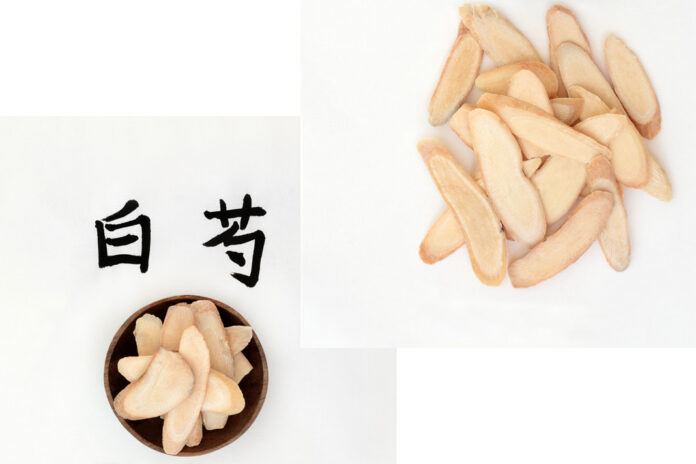Finding A Guiding Herb Makes Easier to Find the Most Efficient Formula ⑥ Shao Yao
Shao Yao Could Help Bloating, Stomach Pain and Loss Stools
By Hyunchang Cho, L.Ac., Ph.D (c0454445@gmail.com)
|
★ Shao Yao Symptom Indicator Score++ Frequency of Use++
Main Symptom ① Hypertonicity (extreme tension) of Shao Yao muscles (mostly flexor muscles) ② Pulling, cramping, twisting, and stiffness due to hypertonicity of brachial biceps, iliopsoas, medial muscles of the thigh, hamstrings, gastrocnemius (medial part), and such are common. Possible Symptoms ③ Abdominal gas leading to bloating and fullness ④ Stomach pain ⑤ Loose or thin stools Muscle Test (w/ palpitation diagnosis) ⑥ Stiffness and tenderness of brachial biceps and iliopsoas muscles, along with small lumps scattered around rectus abdominis, painful upon touch. If Shao Yao signs are positive, we usually select Shao Yao formulas. We can still select Shao Yao formulas without positive Shao Yao signs. |
- Pharmacological Hypothesis of Shao Yao
- Clinical Signs of Shao Yao
|
∙Da Zao vs. Shao Yao |
|
|
Shao Yao muscles are mostly flexor muscles (shown in blue) |
Da Zao muscles are usually extensor and postural muscles (shown in red) |
|
Da Zao |
Shao Yao |
|
Hypertonicity (stiffness) of white tendons in external and postural muscles |
Hypertonicity (stiffness) of red muscles in flexor muscles |
|
Da Zao muscles: triceps, rhomboids, erector spinae, external oblique, inguinal ligament, Iliotibial band, Achilles tendon, plantar fascia, and such Difficulties with extension movements |
Shao Yao muscles: biceps, rectus abdominis, psoas, muscles of the medial thigh, and such Difficulties with flexion movements |
|
Muscle signs: hypertonicity and tenderness in white tendons of triceps and rhomboids ☞Positive Da Zao muscles signs may or may not lead to Da Zao formulas |
Muscle signs: hypertonicity and tenderness in red muscles of biceps and rectus abdominis ☞Positive Shao Yao muscles signs usually lead to Shao Yao formulas |
|
Chest symptoms (shortness of breath) may occur |
Chest symptoms (shortness of breath) rarely occur |
As seen in the picture above, Shao Yao muscles are mostly located in the anterior and medial sides of the body, and Da Zao muscles are usually located in the posterior and lateral sides. This is why we can consider using Shao Yao when flexion movements of muscles in the anterior and medial sides are difficult and painful. When extension movements of muscles in the posterior and lateral sides are hindered, we can consider using Da Zao.
With Da Zao Pattern, we can observe hypertonicity and tenderness in white tendons of triceps and rhomboids. But Da Zao muscle signs are not binding signs, meaning positive Da Zao signs may or may not lead to a selection of Da Zao formulas. We can select Da Zao formulas without positive Da Zao muscle signs. On the other hand, with Shao Yao Pattern, hypertonicity and tenderness in the red muscles of the biceps, iliopsoas, and rectus abdominis are common. Shao Yao muscles signs are binding signs, meaning positive Shao Yao muscle signs usually lead to selecting Shao Yao formulas. We can still select Shao Yao formulas without positive Shao Yao muscle signs.
The target area of Shao Yao seems to be the stomach. This is why Shao Yao formulas can treat stomach disorders. For the same reason, with Shao Yao formulas, chest discomfort such as heart palpitations and chest fullness are mild or absent. But there are exceptions such as Gui Zhi Jia Hou Po Xing Zi Tang, Huang Lian E Jiao Tang, Dang Gui Si Ni Jia Wu Zhu Yu Sheng Jiang Tang, Da Chai Hu Tang, Zhen Wu Tang, Fu Zi Tang, and such. Shao Yao is also rarely used for patients with shortness of breath. But Gui Zhi Jia Hou Po Xing Zi Tang is an exception.
(1) Main Symptoms
|
Hypertonicity (extreme tension) of Shao Yao muscles (mostly flexor muscles) Pulling, cramping, twisting, and stiffness due to hypertonicity of brachial biceps, iliopsoas, medial muscles of the thigh, hamstrings, gastrocnemius (medial part), and such are common. |
In clinical practice, hypertonicity of Shao Yao muscles can appear in virtually all muscles in our body, but it is most common in Shao Yao muscles such as biceps, rectus abdominis, iliopsoas, medial muscles of the thigh, hamstrings, and medial gastrocnemius. These muscles are mostly located in our body’s anterior and medial sides. Hypertonicity and tenderness of Shao Yao muscles can manifest as muscle pains and discomfort such as contracture of the limbs, stiff neck, and pains in the shoulder, low back, stomach, hamstrings, and calf cramps.
Hypertonicity and tenderness of Shao Yao muscles manifest as pulling, cramping, twisting, stiffness, and muscle contracture such as contracture of the limbs in stroke patients and stooped posture in older people.
|
Clinical Expressions * Muscle pains due to hypertonicity, mainly in the muscles of the anterior and medial sides of the body. Muscle cramps, pulling, stiffness, twisting (dystonia), contracture, and such. * Neck stiffness is common. The upper back and shoulders will feel sore, and a limited range of shoulder movement will be seen. Lower back and legs will feel sore.* Lower back pain. Holding the same position for a long time, such as lying down, sitting or standing will aggravate the pain. * When standing up from a squatting or sitting position, the back won’t stretch well, producing soreness and pain. * Stooped back is commonly seen in older people. * Contracture of the limbs seen in stroke or hemiplegia patients. * Nocturnal leg pains due to growing pains * Frequent muscle cramps of the legs. A stretch or overuse will easily lead to cramps. Sports players who suffer from cramps after consecutive games. |

































